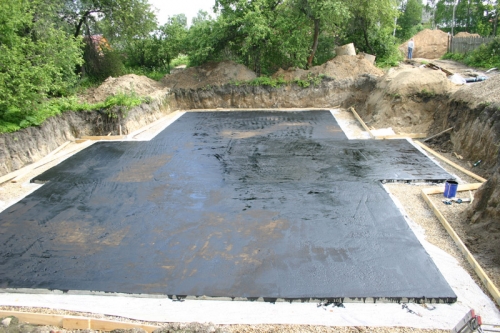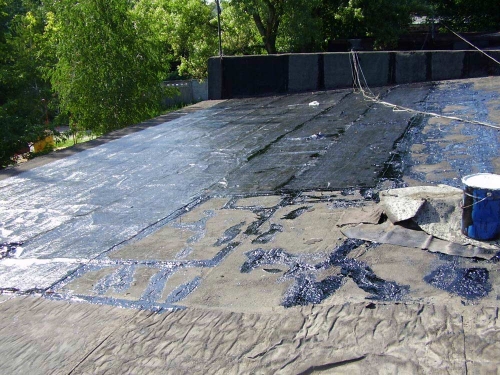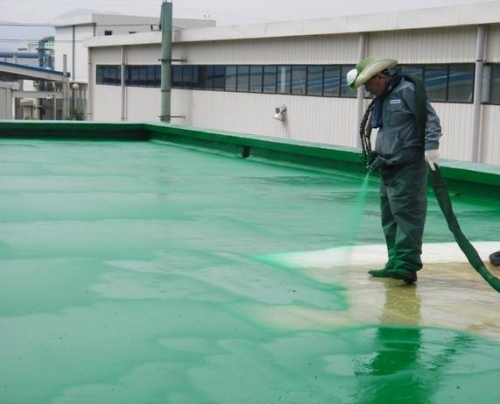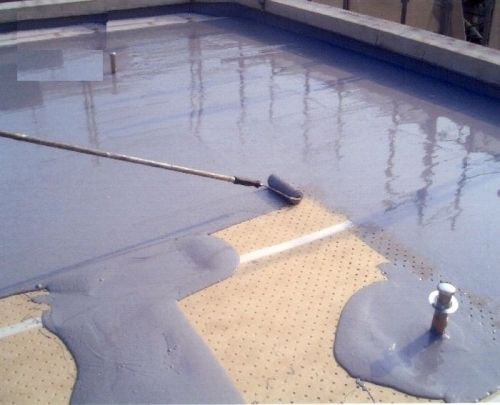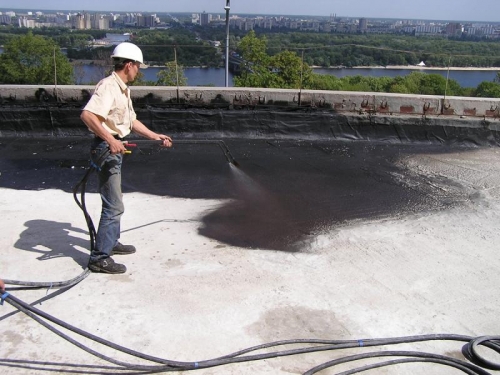Laminate coating is particularly wear -resistant. However, when exposed to ...
|
|
The development of technology annually replenish the construction market with new materials with special ... |
In order for the strip foundation to serve as a reliable support to the house for as long as possible ... |
Roofing mastic
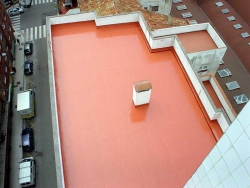
The roof roof every day takes on the blows of nature in the form of the influence of various atmospheric phenomena. Roofing mastic, which is otherwise named afternoon, as independent roofing material has been increasingly used recently when arranging roofs.
Content:
- Roofing mastic
- Classification of mastic
- Requirements for mastic
- The advantages of mastic
- Technology for applying mastic
Roofing mastic
The mastic of roofing hot or cold is a homogeneous, viscous mass that is applied to the roof manually or using a spray. After hardening the previous layer, the next layer is applied. Roofing mastic can be either one -component or two -component. The undoubted plus of a mastic roof is the absence of the use of roller materials and, consequently, joints and seams. The uniform distribution of mastic on the surface of the roof is a prerequisite for the creation of such a roof. Whether it is cold roofing mastic or hot. The mastic of the roofing price, which does not bite, will undoubtedly help in the creation of a reliable roof.
Roofing waterproofing waterproofing is a liquid, viscous homogeneous mass. After applying to the surface and hardening, the mass turns into a monolithic coating similar to rubber. The composition of roofing mastics may include fillers, solvent and various additives. Roofing mastics can be given almost any color, by adding dyes. It has a roofing mastic where, of course, all technical requirements are set out in detail. Mastics can be used both to cover new roofs, and for sealing joints, repairing old roofs, waterproofing, gluing roll materials and anti -corrosion protection. Polymer and bitumen-polymer mastics easily fall on roofing material, steel, concrete and asbestos cement.
The use of roofing mastic reduces construction costs, because the level of mechanization when using a mastic coating reaches 90%. When working using roofing material, the mechanization indicator is only 30%. This allows you to reduce labor costs by almost 2-3 times.
Roofing mastic coatings have a number of advantages:
- High strength;
- Resistance to wind, precipitation, temperature, insolation;
- Resistance to UV: oxidation and radiation;
- Resistance before corrosion;
- A light weight;
- Elasticity.
Mostly roofing mastics are used on flat surfaces, the angle of inclination of which does not exceed 2.5 %. If the inclination of more than 2.5 % of the mastic is mixed with cement or thickeners, add an additional reinforcing mesh made of fiberglass or a fiberglass panel. With an angle of inclination over 25 %, it is not recommended to use roofing mastics and rolls. Mlazelobok, cornice overhang, hobby and yndov are enhanced by an additional layer of mastic in the places of connection with the roof.
Burning roofs are divided into reinforced, uninhabited and combined roofs.
Uninhabited roofs are a continuous, seamless waterproofing coating with a thickness of about 10 mm, formed by the application of several layers of mastic. Gravel or stone crumbs are most often added to the upper layer.
Reinforced roofs continuous, seamless waterproofing coating consisting of three, four or five layers of mastic. Mastic of the bitumen rubber roofing contains in the middle of the layers of glass a grid or a glass sheet. Reinforcement increases strength, but reduces elasticity.
Combined roofs alternating layers of mastic and roller materials. The upper layer of mastic most often contains gravel or is painted with waterproof paint.
Classification of mastic
Roofing mastics are classified according to various signs.
- In composition: one -component and two -component mastics;
- By the method of use: hot and cold mastics;
- In composition of the substance: bitumen, butytil rubber, bitumen-laketh, bitumen-polymer, polymer roof mastics, chlorus-sulf and polyethylene;
- For its intended purpose: roofing-insulating, gluing mastics, waterproofing and asphalt, anti-corrosion;
- By the method of curing: cured mastic and unconditional;
- By type of solvent: containing water, organic solvents, liquid organic substances.
One -component mastic - is supplied already in a ready -made form. Contains a solvent, when disappeared, which is hardened by its composition. Shelf life of no more than three months. An exception is polyurethane mastic, the hardening of which occurs under the action of water vapor. The shelf life of polyurethane mastic in hermetic containers will be 12 months.
Two -component mastic - comes in the form of two inactive components. The shelf life of such a mastic will be more than a year. Mixing the two components allows you to give the coating elasticity or hardness, depending on the operating condition of a mastic roof.
The mastmone roofing, bitumen-polymer and polymer are different from similar roller materials primarily in that they are formed in the coating (membrane) on the surface of the roof.
Requirements for mastic
Roofing mastics during operation should:
- Over the norms, do not distinguish harmful substances into the atmosphere;
- Have a homogeneous structure without the inclusion of various particles;
- Binders are not soaked;
- To biological components to show resistance;
- Firmly glue rolled materials;
- Have stable physical and mechanical characteristics;
- Durable to serve within the limits of norms.
The advantages of mastic
- Easy to use and apply;
- Well amenable to the work of roofing instruments;
- Provide excellent clutch with vertical and horizontal surfaces;
- Form an elastic coating;
- When hardened does not crack;
- Allow you to work in high humidity conditions;
- Significant flexibility at negative temperatures;
- Durability;
- Significant resistance to shrinkage and fluidity;
- Environmental cleanliness;
- The ability to change color;
- Lack of seams.
Technology application of mastics
The surface of the roof must be pre -cleaned from debris and dust. Roofing mastic can be applied in two ways: manual with a spatula and roller and mechanical using a spray. Both methods will provide simple and reliable work. The use of roofing mastics is especially beneficial when the surface of the roof contains various parts and interference for rolled materials. The mastic of the roofing technoinol, for example, can be applied both with preliminary heating and cold. The thickness of the layer of roofing mastic, as a rule, is 1 mm. Such a layer dries in 24 hours. The subsequent layer can only be applied after the previous one has completely dried. The number of layers depends on the angle of inclination, usually create a two -layer coating. Approximately mastic consumption is 1300 grams per square meter at a flat surface. If roofing work occurs in winter, the mastic should be heated in advance at a temperature of 50 degrees Celsius in a closed metal capacity. Often to give the best operational properties to a new coating, it is sprinkled with roofing. We recommend in advance to take care of the drain, since prolonged effects of precipitation can cause harmful coating.

